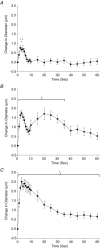Potassium initiates vasodilatation induced by a single skeletal muscle contraction in hamster cremaster muscle
- PMID: 17363384
- PMCID: PMC2075172
- DOI: 10.1113/jphysiol.2007.130013
Potassium initiates vasodilatation induced by a single skeletal muscle contraction in hamster cremaster muscle
Abstract
The rapid onset of vasodilatation within seconds of a single contraction suggests that the vasodilators involved may be products of skeletal muscle activation, such as potassium (K(+)). To test the hypothesis that K(+) was in part responsible for the rapid dilatation produced by muscle contraction we stimulated four to five skeletal muscle fibres in the anaesthetized hamster cremaster preparation in situ and measured the change in diameter of arterioles at a site of overlap with the stimulated muscle fibres before and after a single contraction stimulated over a range of stimulus frequencies (4, 10, 20, 30, 40, 60 and 80 Hz; 250 ms train duration). Muscle fibres were stimulated in the absence and presence of an inhibitor of a source of K(+), the voltage dependent K(+) channel inhibitor 3,4-diaminopyridine (DAP, 3 x 10(-4) M) and inhibitors of the K(+) dilatory signal transduction pathway, either a Na(+) K(+)-ATPase inhibitor (ouabain; 10(-4) M) or an inward rectifying K(+) channel inhibitor (barium chloride, BaCl(2); 5 x 10(-5) M). We observed significant inhibitions of the rapid dilatation at all stimulus frequencies with each inhibitor. The dilatory event at 4 s was significantly inhibited at all stimulus frequencies by an average of 65.7 +/- 3.6%, 58.8 +/- 6.1% and 64.4 +/- 2.1% in the presence DAP, ouabain and BaCl(2), respectively. These levels of inhibition did not correlate with non-specific changes in force generation by skeletal muscle measured in vitro. Therefore, our data support that K(+) is involved in the rapid dilatation in response to a single muscle contraction across a wide range of stimulus frequencies.
Figures





Similar articles
-
Extracellular adenosine initiates rapid arteriolar vasodilation induced by a single skeletal muscle contraction in hamster cremaster muscle.Acta Physiol (Oxf). 2013 May;208(1):74-87. doi: 10.1111/apha.12060. Epub 2013 Feb 8. Acta Physiol (Oxf). 2013. PMID: 23297742
-
Skeletal muscle contraction-induced vasodilator complement production is dependent on stimulus and contraction frequency.Am J Physiol Heart Circ Physiol. 2009 Jul;297(1):H433-42. doi: 10.1152/ajpheart.00216.2009. Epub 2009 May 22. Am J Physiol Heart Circ Physiol. 2009. PMID: 19465553
-
Prostaglandins induce vasodilatation of the microvasculature during muscle contraction and induce vasodilatation independent of adenosine.J Physiol. 2014 Mar 15;592(6):1267-81. doi: 10.1113/jphysiol.2013.264259. Epub 2014 Jan 27. J Physiol. 2014. PMID: 24469074 Free PMC article.
-
Potassium regulation during exercise and recovery in humans: implications for skeletal and cardiac muscle.J Mol Cell Cardiol. 1995 Apr;27(4):1011-22. doi: 10.1016/0022-2828(95)90070-5. J Mol Cell Cardiol. 1995. PMID: 7563098 Review.
-
Skeletal muscle vasodilatation at the onset of exercise.J Physiol. 2007 Sep 15;583(Pt 3):825-33. doi: 10.1113/jphysiol.2007.135673. Epub 2007 Jul 5. J Physiol. 2007. PMID: 17615103 Free PMC article. Review.
Cited by
-
Dynamic response characteristics of hyperaemia in the human calf muscle: effect of exercise intensity and relation to electromyographic activity.Eur J Appl Physiol. 2012 Dec;112(12):3997-4013. doi: 10.1007/s00421-012-2362-4. Epub 2012 Mar 23. Eur J Appl Physiol. 2012. PMID: 22441829
-
Functional implications of microvascular heterogeneity for oxygen uptake and utilization.Physiol Rep. 2022 May;10(10):e15303. doi: 10.14814/phy2.15303. Physiol Rep. 2022. PMID: 35581743 Free PMC article. Review.
-
ATP-mediated vasodilatation occurs via activation of inwardly rectifying potassium channels in humans.J Physiol. 2012 Nov 1;590(21):5349-59. doi: 10.1113/jphysiol.2012.234245. Epub 2012 Jul 9. J Physiol. 2012. PMID: 22777673 Free PMC article. Clinical Trial.
-
Amplification of endothelium-dependent vasodilatation in contracting human skeletal muscle: role of KIR channels.J Physiol. 2019 Mar;597(5):1321-1335. doi: 10.1113/JP276998. Epub 2018 Dec 26. J Physiol. 2019. PMID: 30506579 Free PMC article. Clinical Trial.
-
Inward rectification and vascular function: as it was in the beginning.J Physiol. 2008 Mar 15;586(6):1465-7. doi: 10.1113/jphysiol.2008.151308. Epub 2008 Feb 7. J Physiol. 2008. PMID: 18258660 Free PMC article. Review. No abstract available.
References
-
- Amberg GC, Koh SD, Imaizumi Y, Ohya S, Sanders KM. A-type potassium currents in smooth muscle. Am J Physiol Cell Physiol. 2003;284:C583–C595. - PubMed
-
- Baez S. An open cremaster muscle preparation for the study of blood vessels by in vivo microscopy. Microvasc Res. 1973;5:384–394. - PubMed
-
- Beach JM, McGahren ED, Duling BR. Capillaries and arterioles are electrically coupled in hamster cheek pouch. Am J Physiol Heart Circ Physiol. 1998;275:H1489–H1496. - PubMed
-
- Beaune B, Fellmann N, Villie F, Marcollet M, Coudert J. Effects of orchiectomy on EDL muscle ultrastructure and energy-supplying enzymes in growing male guinea pigs. Am J Physiol Cell Physiol. 1994;266:C143–C148. - PubMed
-
- Berg BR, Cohen KD, Sarelius IH. Direct coupling between blood flow and metabolism at the capillary level in striated muscle. Am J Physiol Heart Circ Physiol. 1997;272:H2693–H2700. - PubMed
Publication types
MeSH terms
Substances
LinkOut - more resources
Full Text Sources
Medical

